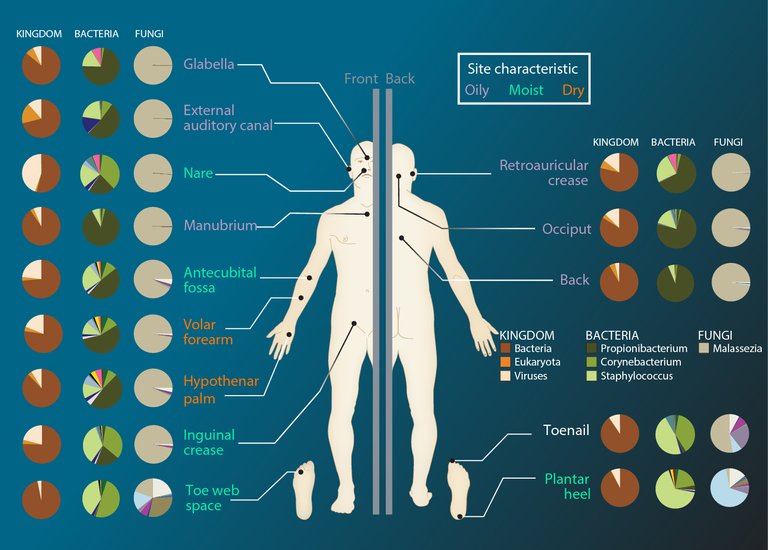From Harmful Germs to Essential Partners; Looking at the Intricate Relationship between Microbes and Humans
Microbes and humans share a complex relationship that can be difficult to classify as strictly commensal, parasitic, or predator-prey. Our world is teeming with trillions upon trillions of microbes, ubiquitous yet invisible to our naked eyes due to their microscopic size. While we, as macroscopic beings, harbor billions of microbes within our bodies, it is important to acknowledge that we do not always coexist harmoniously.
Throughout history, humans have had the longest interaction with microbes, but our encounters have often been unpleasant, associating them with diseases that range from a mere sneeze to serious illnesses and even death. An infamous example is Cercaria, which causes Cercarial Dermatitis or Swimmer's itch, resulting in a rash when these parasites penetrate our bodies.

needpix
Initially, we were unable to perceive these microorganisms until the advent of magnifying lenses and modern microscopes, which provided us with a glimpse into the realm of microorganisms. However, humans have long been aware of the existence of this tiny world. As far back as 30 BC, Marcus Terentius Varro, a Roman scholar, mentioned these microorganisms, which he called animacules, emphasizing their invisibility to the naked eye. Varro issued warnings about spending time near swamps, describing these animacules as pervasive organisms capable of causing illness when ingested through the mouth or nose.
This intricate relationship with microbes begins at birth. While we are sterile in our mother's womb, upon passing through the birth canal, we acquire a multitude of microbes from our mother. Research has demonstrated that these initial microbial colonizers play a crucial role in our health. Studies indicate that children born via Cesarean section have a higher incidence of asthma, leukemia, and other immune-related disorders, suggesting the importance of the microbiota acquired during natural childbirth.
Following birth, mothers breastfeed their infants, and numerous studies have shown that breast milk facilitates the establishment of beneficial microbial strains such as Bifidobacterium, Lactobacillus, Enterococcus, and Staphylococcus. Each individual possesses a unique collection of microbiomes comprising bacteria, fungi, and viruses. Some microorganisms reside on our skin as part of the normal microflora, acting as a defense against invading microorganisms. Others inhabit our oral cavity, with approximately 1000 types of bacteria present, which can dominate if proper hygiene is neglected. Additionally, we harbor specific gut microbes that are vital to our well-being and protected by our immune system.
The significance of gut microbes cannot be overstated. For instance, it is noteworthy that 90% of serotonin, a neurotransmitter crucial for regulating mood, is produced in the gut as a result of microbiome interactions with the vagus nerve. These interactions trigger the production of neurotransmitter precursors. While gut bacteria have positive effects, research has shown their involvement in weight gain, obesity, insulin resistance, and low-grade inflammation caused by the production of lipopolysaccharides (LPS). However, they can also contribute to weight loss by influencing our eating habits and nutritional choices. Furthermore, gut bacteria aid in the activation of immune cells, facilitating brain recovery after traumatic injuries.
If I were to inquire about the first word you learned as a child when introduced to microbes, it would likely be "germs." This term was used to caution us about microorganisms, painting them in a negative light. However, as we grow and delve into the realm of science, we begin to realize that the notion of microbes solely causing harm is overly simplistic. I previously mentioned microbiomes, but we also have probiotics.
While many microbes can cause illness, the majority of microbial species are harmless. The pathogenic species constitute a small percentage of the overall microbial population. Our relationship with microbes is incredibly intricate, with an estimated 38 trillion microbial colonies in our bodies, surpassing the number of human cells, estimated at 37 trillion. This implies that we play host to more microbial organisms than our own cells.
Microbiomes are as unique to individuals as their fingerprints, with no two human beings sharing the exact same composition or quantity of microbiomes.
Reference
https://www.ncbi.nlm.nih.gov/pmc/articles/PMC9110848/
https://www.ncbi.nlm.nih.gov/pmc/articles/PMC7231147/
https://www.ncbi.nlm.nih.gov/pmc/articles/PMC8234057/
https://www.ncbi.nlm.nih.gov/pmc/articles/PMC7333005/
https://www.ncbi.nlm.nih.gov/pmc/articles/PMC9455721/
https://www.ncbi.nlm.nih.gov/pmc/articles/PMC8552843/
https://www.ncbi.nlm.nih.gov/pmc/articles/PMC4991899/
https://biologydictionary.net/how-many-cells-are-in-the-human-body/
https://www.cdc.gov/parasites/swimmersitch/index.html
https://www.niehs.nih.gov/health/topics/science/microbiome/index.cfm
https://microbiomejournal.biomedcentral.com/

Hi, I am Tobi a writer, speaker, relationship blogger, and lover of good music. I love making friends and learning from people. Want to hear me speak on relationships and general life issues, you can find my youtube channel where you can listen and watch any episode for free, please do not forget to subscribe, friends. I sincerely appreciate every love I get from here, kindly do well to keep them coming.

Sometimes I wonder if microbes are our friends or our enemies. Majority of our discovery in the health world and even in other fields can be attributed to them but the relationship with them is very confusing. In reality, when we hear the word Microorganism, it comes with lots of hate and fear because the first word we actually learned about them was germs.
Thanks for your contribution to the STEMsocial community. Feel free to join us on discord to get to know the rest of us!
Please consider delegating to the @stemsocial account (85% of the curation rewards are returned).
Thanks for including @stemsocial as a beneficiary, which gives you stronger support.